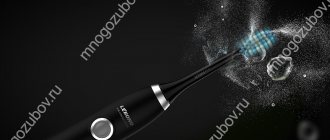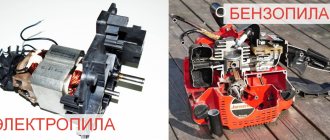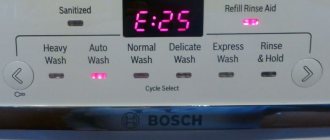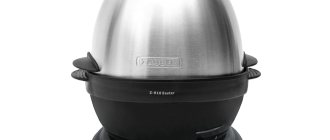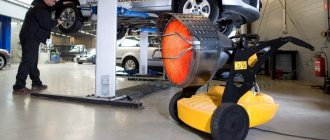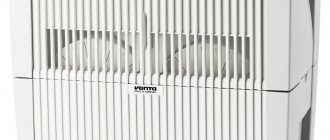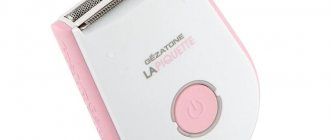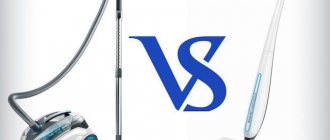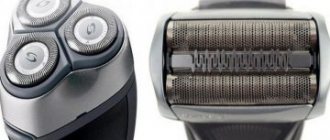In this article
- How does an electric toothbrush work?
- Design features and operating principle of the irrigator
- Irrigator or brush: is it worth choosing?
- What is better - a waterpik or a toothbrush?
When thinking about quality oral hygiene, many people ask the question: which is better - a waterpik or an electric toothbrush? To answer this question, you first need to understand how both of these devices work and what problems they solve.
How does an electric toothbrush work?
An electric brush is a more technologically advanced version of a regular toothbrush. It is a tool for primary oral hygiene, helps remove food debris from the surface of the teeth, clean the enamel from soft and hard plaque.
The difference between an electric brush and a regular toothbrush is the vibration of the bristles, which is provided by the operation of an electric motor. Most often, the motor is built into the handle of the device and is powered by batteries or a rechargeable battery.
The bristles of an electric toothbrush can move in different directions - in a circle or up and down, effectively softening and removing mineral plaque.
Electric toothbrushes are divided into different types based on the speed of movement of the bristles.
- Sound model.
It cleans the surface of the teeth thanks to a combination of sound waves and vibrations of the bristles with a certain amplitude. Such a device makes more than 20 thousand movements per minute and, with the help of friction, even removes plaque, preventing it from hardening and forming deposits on the teeth. Using sound models with different attachments helps keep teeth clean and prevents the formation of stones.
- Ultrasonic toothbrush.
It creates an ultrasound wave that is inaudible to the human ear, so it works almost silently, but provides high quality teeth cleaning. An ultrasonic brush not only effectively removes large stains, but also has a destructive effect on bacteria that form plaque on teeth. It copes with soft and pigmented plaque, promotes better penetration of cleaning pastes into the tissues of the oral cavity.
Most models have power regulators and several operating modes, which makes their use as convenient and comfortable as possible. Among the disadvantages, one can note a rather rough effect on crowns, veneers and fillings, which can lead to their early wear and destruction.
Which is better: an electric toothbrush or a water flosser?
The choice depends on the goal to be achieved. Single use of an irrigator can cause irreparable harm to the human body. Similarly, too frequent use of electric brushes can destroy even completely healthy teeth.
Irrigator research results
- Regular oral brushing reduces the risk of plaque by 25%.
- Reading efficiency increases by 52%.
- Caries damage is minimized to 30%.
- Prevents bad breath by 35%.
Clinical trials using electric brushes
- Freshens breath for an average of 2-3 hours.
- Reduces cleaning time by 55%.
- Helps save dental hygiene products by 94%.
- Reduces the number of bacteria on the enamel surface by 34%.
So it is advisable to have both an electric toothbrush and a water flosser for use 2-3 times a week.
Design features and operating principle of the irrigator
Both brushes and irrigators are designed for oral hygiene. But these devices are not identical in their purpose. If an electric toothbrush is a primary hygiene item, then an irrigator is a secondary item. This means that any cleaning should begin with the use of a brush, which removes the main contaminants, and only then can you proceed to cleansing the oral cavity with an irrigator. It does not replace a toothbrush, but helps to bring the cleaning result to perfection. How does this device work and work?
It is a device that delivers a directed stream of pulsating water under pressure into the oral cavity. Contacting the teeth and gums, the jet cleans well those areas where the brush cannot reach. Using an irrigator, it is convenient to clean the interdental spaces without traumatizing the gums, take care of braces, implants, dentures, and wash away food debris and dirt from gum pockets and from under dental structures.
The irrigator acts on the gums much more delicately, provides a gentle massage, improves blood flow, and strengthens the gums. Since the irrigator can remove dirt even from difficult areas, there are almost no germs left in the oral cavity, which effectively solves the problem of unpleasant odor.
Dentists recommend using this device to everyone who cares about the health of their teeth, but especially to people with sensitive gums and those who wear dental appliances.
Despite the advantages of this device, it cannot be said that the irrigator is better than an electric toothbrush. It cannot be a full-fledged replacement, since a stream of water does not provide a 100% mechanical cleaning effect. The device cannot completely remove complex plaque and tartar; a brush and paste are needed to solve this problem. But as complementary hygiene products, a water flosser and an electric toothbrush work very effectively.
Purpose of the irrigator
An irrigator is a new generation device designed to perform several functions. Among them:
- cleaning hard-to-reach areas of the oral cavity;
- gum massage;
- delayed stone formation.
It removes food debris in places where neither a manual nor an electric toothbrush has access. The principle of its operation is to supply a very thin stream of water or medicinal solution under strong pressure. That is, in fact, it “washes out” everything that remains after brushing with a toothbrush and also perfectly massages the gums, reduces their inflammation, strengthens and improves blood circulation in them.
The device consists of a reservoir for liquid and nozzles; according to the method of operation, it is divided into two types: stationary and portable. Each type has its own advantages. In the first case it is power, and in the second it is mobility.
The device is perfect for both daily use and for the treatment of periodontal disease and other diseases of the oral cavity.
For this purpose, instead of ordinary water, special medicinal decoctions or solutions are used. As a rule, one device, with different attachments, can be used by all family members.
Irrigator or brush: is it worth choosing?
If the choice is “irrigator or electric brush,” many will prefer the latter, since it is an item of primary hygiene.
There is still an opinion that it is not necessary to use an irrigator, and for good hygiene it is enough to choose a good brush.
In fact, it is wrong to put yourself before the choice of “irrigator or electric toothbrush.” Just as the first cannot replace the second, the brush cannot effectively cope with the tasks that the irrigator solves.
The bristles cannot fully clean the interdental spaces or remove food debris from under bridges and other orthopedic and orthodontic structures. The brush is not able to provide useful hydromassage for the gums, which serves as a prevention of bleeding, periodontal disease, and inflammatory processes. Even the best quality brush cannot clean your braces as well and as carefully as a pulsating stream of water will.
Dentists are sure: there is no need to choose what works best. The best option is to use all available means for hygiene of teeth and gums.
By using an irrigator, toothbrush and floss at the same time to care for the oral cavity, you can achieve maximum cleaning results, ensure healthy teeth and gums, and prevent the development of a number of dental diseases. It is important to use the available tools in the correct order.
- The first stage is mechanical cleaning with a brush and paste.
- The second is to use dental floss to remove dirt from between teeth. If you have sensitive gums that immediately bleed from contact with the thread, then you can abandon the second stage and immediately move on to the next one.
- The third stage is cleaning with an irrigator. When the main contaminants have been removed, it's time to begin the final procedure. The water jet penetrates into hard-to-reach areas and removes all remaining dirt, ensuring impeccable oral hygiene.
Is a portable irrigator a substitute for an electric toothbrush?
A portable irrigator cannot replace either an electric or a manual toothbrush, because these devices perform different functions. An electric brush is a primary hygiene item, and an irrigator is a secondary item. An electric brush cannot fully clean the spaces between the teeth, treat the tongue, and gum pockets, where it often drives microorganisms.
It cannot provide hydromassage of the gums, which serves as a prevention of bleeding, periodontal disease, and inflammatory processes. The highest quality electric brush cannot clean braces as well and carefully as a pulsating stream of water from an irrigator will do.
An electric brush is used to clean the surface of the teeth, and an irrigator is used to treat hard-to-reach areas between them, near crowns, and under braces. It also performs a strengthening hydromassage of the gums using pulsating water jets, providing the ideal frequency for the oral cavity.
What is better - a waterpik or a toothbrush?
The very formulation of the question - “brush or irrigator” - is incorrect. You can compare devices that have a similar operating principle or perform the same functions. The design and operating features of a brush and a dental irrigator are different. An irrigator does not replace a brush; these devices solve different dental problems in different ways. Therefore, it is wrong to say that it will be better to clean your teeth. The best option is comprehensive cleaning using an irrigator and a high-quality electric toothbrush.
Please note that these devices may be contraindicated for people with certain dental diseases and conditions. Therefore, before the first use, it is advisable to visit a dentist, check the condition of the oral cavity and, together with a professional, select the optimal hygiene care regimen.
Features of electric toothbrushes with irrigator
According to research, an electric toothbrush, by performing pulsating circular rotations, can halve the time spent on daily hygiene procedures, reduce waste on hygiene products by a third, and also more effectively control the microbial environment. However, due to the peculiarities of its structure, it is not able to cope with the removal of plaque and food debris in hard-to-reach areas of the periodontium , which does not reduce the likelihood of the development of pathogenic microflora and carious lesions.
Important! To ensure complete hygiene, an integrated approach is required, which involves the use of modern irrigation systems (irrigators), which double the cleaning efficiency, prevent the development of dental diseases and unpleasant odor due to the ability to penetrate hard-to-reach areas of the interdental space.
By developing modern methods of effective hygiene, manufacturers offer a comprehensive solution in the form of stationary and portable platforms - dental centers , which combine an electric brush and irrigator. The system involves the use of two types of devices or one device by replacing the nozzle.
Multifunctionality involves effective cleaning of plaque from the surface of the enamel and tongue, hydromassage of the gums, as well as professional care of orthodontic and orthopedic structures.
The systems offer a large selection of attachments, are equipped with adjustment sensors, pressure control and pulsation frequency , as well as reservoirs for water or dental rinses.
Expert opinion: will a waterpik replace a toothbrush?
Often, an oral irrigator is a mysterious device for the average person, which, many believe, can completely replace cleaning the oral cavity with other means. According to others, it is a highly advertised useless device. To dispel all the myths, we turned to the specialists of the ANO “Association “Dentistry”. Our questions were answered by the head of the treatment and prophylactic department, dentist-therapist, periodontist Nina Zakharova.
— Nina Igorevna, tell us, in what cases is it recommended for a patient to use an irrigator and brush teeth under pressure?
First of all, if a person has crowded teeth, there are braces or veneers, crowns, and periodontal pockets. Many people use this device to feel clean in their mouth. The principle of its operation is quite simple: the surface is treated with a strong stream of water, which removes food debris from hard-to-reach places.
— What should be the temperature of the water poured into the irrigator?
The temperature should be about +40 °C, because cold water can negatively affect the enamel and increase tooth sensitivity. — How to use the irrigator correctly? It is necessary to begin cleaning in a gentle mode, gradually increasing the pressure. In addition, to create a feeling of a pleasant fresh smell, you can optionally add rinse aid to the irrigator reservoir. The irrigator must be held at an angle of 90 degrees to the area currently being treated, gradually moving from tooth to tooth. The head must be tilted so that during cleaning the already used liquid flows freely from the mouth.
— What to do if your gums bleed when using an irrigator?
We need to reduce the pressure and pay more attention to this area! In any case, consultation with a dentist is necessary.
— Probably the most interesting question: is it possible to use only a waterpik instead of a toothbrush?
There are many different means of dental prevention: the most common is, of course, toothbrushes; the market offers all sorts of options, ranging from the simplest to electric. In addition, dental floss, rinses and balms are used. After these products we can call oral irrigators. There is an opinion that irrigators are a universal device for cleaning the oral cavity, that they can replace all hygienic devices and provide the necessary cleanliness. But this is far from true. Oral hygiene should be carried out in combination with all these means. Let me also remind you that the patient also needs to remember to visit the dentist twice a year.
Contraindications are possible; specialist consultation is required.
